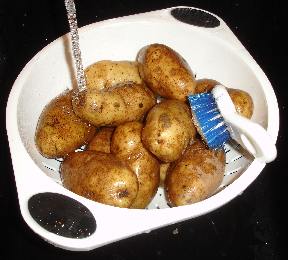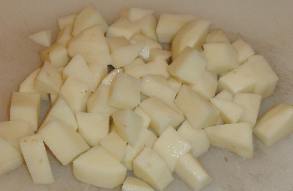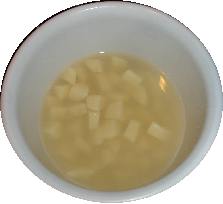
Looking for How to Freeze Potatoes - Easily! With Step-by-step Photos, Recipe, Directions, Ingredients and Costs in 2025? Scroll down this page and follow the links. And if you bring home some fruit or vegetables and want to can, freeze, make jam, salsa or pickles, see this page for simple, reliable, illustrated canning, freezing or preserving directions. There are plenty of other related resources, click on the resources dropdown above. If you are having a hard time finding canning lids, I've used these, and they're a great price & ship in 2 days.
If you have questions or feedback, please let me know! There are affiliate links on this page. Read our disclosure policy to learn more.
How to Freeze Potatoes - Easily! With Step-by-step Photos, Recipe, Directions, Ingredients and Costs
How to Freeze Potatoes
Click here for a PDF print version (coming soon)
Your potato harvest is huge. You've filled the root cellar or basement, but you still have more left. No what? Is there room in the freezer? Here's how to do it, complete instructions in easy steps and completely illustrated. And it is much easier than you think!
Directions for Freezing Potatoes
Potatoes
Cool, drain
Seal and freeze.
Ingredients and Equipment
- potatoes (see step 1)
- A sharp, large serrated knife
- A large pot of boiling water
- Freezer bags
Recipe and Directions
Step 1 - Choose and wash your potatoes
Select smooth new potatoes directly from the garden. Peel or scrape and wash.
Step 2 - Peel thee potatoes, and remove any soft or discolored spots
Just like when you were in the army! And if you weren't, just use a paring knife or peeler to peel them and cut out eyes and any soft or discolored areas.
NOTE: According the North Carolina Cooperative Extension Service at NC State University, to Potatoes must be peeled before canning. Potato skins contain a high bacteria count increasing the chance of botulinum toxin formation.
Step 3 - Cut the potatoes into cubes
 Small
potatoes (2 inches or less) may be left whole. Larger potatoes should be
cubed, cut into 1/2 inch cubes. If you are unsure which to do, the
uniform size of the cubed potatoes produces a higher quality finished
product.
Small
potatoes (2 inches or less) may be left whole. Larger potatoes should be
cubed, cut into 1/2 inch cubes. If you are unsure which to do, the
uniform size of the cubed potatoes produces a higher quality finished
product.
 Step
4 - Soak in Lemon Juice Solution or Ascorbic Acid or Fruit Fresh solution
Step
4 - Soak in Lemon Juice Solution or Ascorbic Acid or Fruit Fresh solution
Place in ascorbic acid solution (1 cup lemon juice to 1 gallon of water, or 2 tablespoons of fruit Fresh to a gallon of water) to prevent darkening; until you get the jars filled. How long is pretty much immaterial; your are trying to keep the potatoes from being exposed to air until you can get them sealed in the jars. The ascorbic acid / lemon juice prevents oxygen dissolved in the water from browning the cut potatoes, too!
Step 5 - Drain
Just pour off the water and discard it. Obviously, KEEP the potatoes...
Step 6 - Blanch the potatoes
Water blanch for 3 to 5 minutes, depending on the size.
Blanching (scalding vegetables in boiling water or steam for a short time) is a must for almost all vegetables to be frozen. It stops enzyme actions which can cause loss of flavor, color and texture. Blanching cleanses the surface of dirt and organisms, brightens the color and helps retard loss of vitamins. It also wilts or softens vegetables and makes them easier to pack.
Blanching time is crucial and varies with the vegetable and size. Underblanching stimulates the activity of enzymes and is worse than no blanching. Overblanching causes loss of flavor, color, vitamins and minerals. Use one gallon water per pound of prepared vegetables. Put the vegetable in a blanching basket and lower into vigorously boiling water. Place a lid on the blancher. The water should return to boiling within 1 minute, or you are using too much vegetable for the amount of boiling water. Start counting blanching time as soon as the water returns to a boil. Keep heat high for the time given in the directions for the vegetable you are freezing.
Step 7 - Cool
Let in ice water for 5 to 10 minutes, then drain..
Step 8 - Pack
Pack into containers, leaving 1/2-inch headspace. You can pack it containers, like Ziploc bags or plastic containers, exclude as much air as you can, and freeze it!
Step 9 - Freeze
Seal and freeze.
... or to start making tasty treats.
Freezing keeps potatoes safe to eat almost indefinitely, but the recommended maximum storage time of 12 months is best for taste and quality. The quality of the frozen potatoes is maintained best in a very cold freezer (deep freezer), and one that keeps them frozen completely with no thaw cycles. Excluding any air from inside the bags which leads to freezer burn, by using vacuum-sealed bags, is also important to maintaining quality
Looking for canning equipment and supplies?
Water bath canner with a jar rack
Pressure canners for gas, electric and induction stoves: Presto 23Qt or T-fal 22Qt
Canning scoop (this one is PERFECT)
Ball Blue book (most recent version)
Jars: 8oz canning jars for jams
Find Other types of farms:
Farm markets and roadside stands
Road trips and camping resources
Local Honey, apiaries, beekeepers
Consumer fraud and scams information
Home canning supplies at the best prices on the internet!
Maple Syrup Farms, sugarworks, maple syrup festivals
Environmental information and resources
Farms For Your Event for birthday parties, weddings, receptions, business meetings, retreats, etc.
Festivals - local fruit and vegetable festivals
Get the
most recent version of
the Ball Blue Book
With this Presto 23 quart pressure canner and pressure cooker, you can "can" everything, fruits, vegetables, jams, jellies, salsa, applesauce, pickles, even meats, soups, stews. Model 01781

You can make jams, jellies, can fruit, applesauce, salsa and pickles with water bath canners, like this Granite Ware 12-Piece Canner Kit, Jar Rack, Blancher, Colander and 5 piece Canning Tool Set

